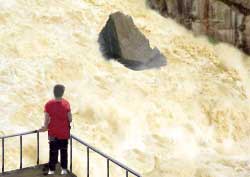Tiger Leaping Gorge
 Why
Tiger Leaping Gorge
is special
Why
Tiger Leaping Gorge
is specialVisitors witness an incredibly loud, churning, foaming river relentlessly pounding giant boulders in its path. Tiger Leaping Gorge is an unforgettable display of powerfully intense raw nature.
Tiger Leaping Gorge tips and insights
Name
Tiger Leaping Gorge got its name because, legend tells us, a tiger escaped a hunter by jumping over the river. The Chinese name of Tiger Leaping Gorge is Hutiao (pronounced who-tee'yhow).
Setting
Tiger Leaping Gorge is 15 kilometers (9 miles) long with many white water rapids. This rocky gorge is flanked by mountains on both sides that sharply rise 3,000 meters (10,000 feet) above the river. The canyon's narrowest point is just 30 meters (100 feet) wide. It has a riverside observation platform for upclose viewing. There, the river water sounds like a roaring angry monster.
When to come
Spring is by far the best time to visit Tiger Leaping Gorge because the river turbulence is at its peak (melting snow flows down from the Himalayan mountains). Fall is the second best period because of its generally pleasant weather. Rains are heaviest during late summer.
Yangtze River
The water that flows through the Tiger Leaping Gorge is the upper reaches of the Yangtze River, near the beginning of its long journey to sea. (Note: The river is named Jinsha River in this part of China).
Getting there
There are two basic routes through the Tiger Leaping Gorge. One is the road that hugs the river. The second is by footpath which runs high above the river. The latter offers better adventure and vistas, but is recommended only to fit, experienced mountain trekkers as it is hazardously narrow and precipitous.
Nearest major city
Tiger Leaping Gorge is a couple of hours drive from the town of Lijiang, which is 340 kilometers (210 miles) northwest of Kunming, the capital of Yunnan province.


